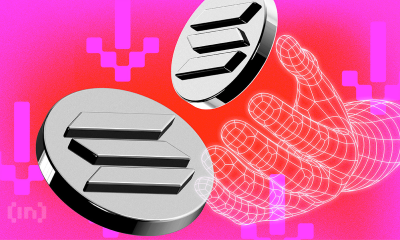Market
600,000 Potential KYC Violations Uncovered


South Korea’s Financial Intelligence Unit (FIU), part of the Financial Services Commission (FSC), uncovered a staggering 500,000 to 600,000 suspected violations of Know Your Customer (KYC) requirements at Upbit, the country’s largest cryptocurrency exchange.
The discovery comes during a meticulous review of Upbit’s business license renewal application, raising concerns about potential legal and regulatory ramifications.
Potential KYC Violations on Upbit
Local media reported that according to sources within South Korea’s financial sector, the FIU’s findings were the result of an intensive inspection that began in late August. The violations pertain to lapses in Upbit’s customer verification processes, a crucial component of anti-money laundering (AML) and counter-terrorist financing (CTF) measures.
Examples of breaches include accounts being approved despite incomplete or blurred identification documents. According to the financial regulator, this could facilitate illicit activities such as money laundering.
An official from Upbit reportedly refrained from commenting on the FIU’s ongoing review, citing confidentiality clauses. However, the exchange’s operational future hangs in the balance as financial authorities verify the validity of the flagged cases. Potential fines of up to 100 million won (approximately $75,000) per violation loom.
This is not the first time Upbit has been scrutinized. South Korean authorities have consistently monitored the exchange due to its dominant position in the local crypto market. Of note is that it is the largest trading volume in the South Asian region.
As BeInCrypto reported, South Korean lawmakers recently opened an investigation against Upbit. The probe centered on the monopoly structure of the virtual asset market built around the trading platform. Similarly, listings on Upbit have been known to cause significant market fluctuations, leading to questions about transparency and fair practices.
Upbit Listings Remain Controversial
Recently, Upbit’s move to expand the Uniswap (UNI) trading pair caused a 150% volume spike for the decentralized exchange token. Similarly, the exchange’s popularity boosted Cat in a Dogs World (MEW) to a new peak, also following trading pair expansion. Other tokens that have benefited from trading activities on Upbit include Injective (INJ) and real-world asset (RWA) token Ondo Finance (ONDO).
Nevertheless, it is impossible to ignore the prevalence of South Korean traders engaging in “pump and dump” schemes, particularly for altcoins. As noted by CryptoQuant CEO Ki Yong Ju, some traders exploit Upbit’s listings to artificially inflate token prices before selling them off, leaving other investors at a loss.
“Korean crypto traders love pumping & dumping altcoins, ironically,” Young Ju noted, demonstrating with a video.
In addition, traders tend to exploit the Kimchi premium, a price gap between South Korean and overseas exchanges. While these practices are not directly linked to Upbit’s management, the exchange’s listings wield an undeniable influence on the market.
Meanwhile, even in the face of ongoing regulatory challenges, Upbit has recently taken steps to enhance transparency and user protection. In July, the exchange issued its first public disclosure under the newly enacted Virtual Asset User Protection Act. This testified to Upbit’s financial stability, user asset holdings, and risk management practices, reflecting an effort to align with changing regulatory standards.
Additionally, Upbit has made strides in global compliance. In January, it secured a Digital Payment Token Services License from Singapore’s Monetary Authority of Singapore (MAS). This milestone followed an earlier conditional approval from the same regulator. The license reflects Upbit’s commitment to regulatory adherence in international markets, even as it faces scrutiny at home.
Notwithstanding, the FIU’s findings could have far-reaching implications for Upbit, both domestically and internationally. While the financial watchdog has yet to announce definitive conclusions, the scale of potential violations could result in hefty fines.
Furthermore, besides reputation damage, the case may prompt broader discussions about KYC practices and regulatory compliance across South Korea’s growing crypto sector. Upbit’s influence as a market leader makes its actions particularly significant. Beyond dominating South Korea’s trading volume, Upbit also shapes trends and token adoption rates.
Disclaimer
In adherence to the Trust Project guidelines, BeInCrypto is committed to unbiased, transparent reporting. This news article aims to provide accurate, timely information. However, readers are advised to verify facts independently and consult with a professional before making any decisions based on this content. Please note that our Terms and Conditions, Privacy Policy, and Disclaimers have been updated.
Market
What to Expect After March’s Struggles

The leading altcoin, Ethereum, experienced a challenging month in March, marked by a series of bearish trends that reflected a broader market slowdown.
However, as the market begins to show signs of recovery, the key question for April remains: Can Ethereum regain its bullish momentum?
Ethereum’s March Woes: Price Crash, Activity Slump, and Growing Supply Pressure
On March 11, Ethereum plummeted to a two-year low of $1,759. This prompted traders to “buy the dip,” triggering a rally to $2,104 by March 24.
However, market participants resumed profit-taking, causing the coin’s price to fall sharply for the rest of the month. On March 31, ETH closed below the critical $2,000 price level at $1,822.
Amid ETH’s price troubles, the Ethereum network also experienced a severe decline in activity in March. Per Artemis, the daily count of active addresses that completed at least one ETH transaction fell by 20% in March.
As a result, the network’s monthly transaction count also plummeted. Totaling 1.06 million during the 31-day period in review, the number of transactions completed on Ethereum fell by 21% in March.
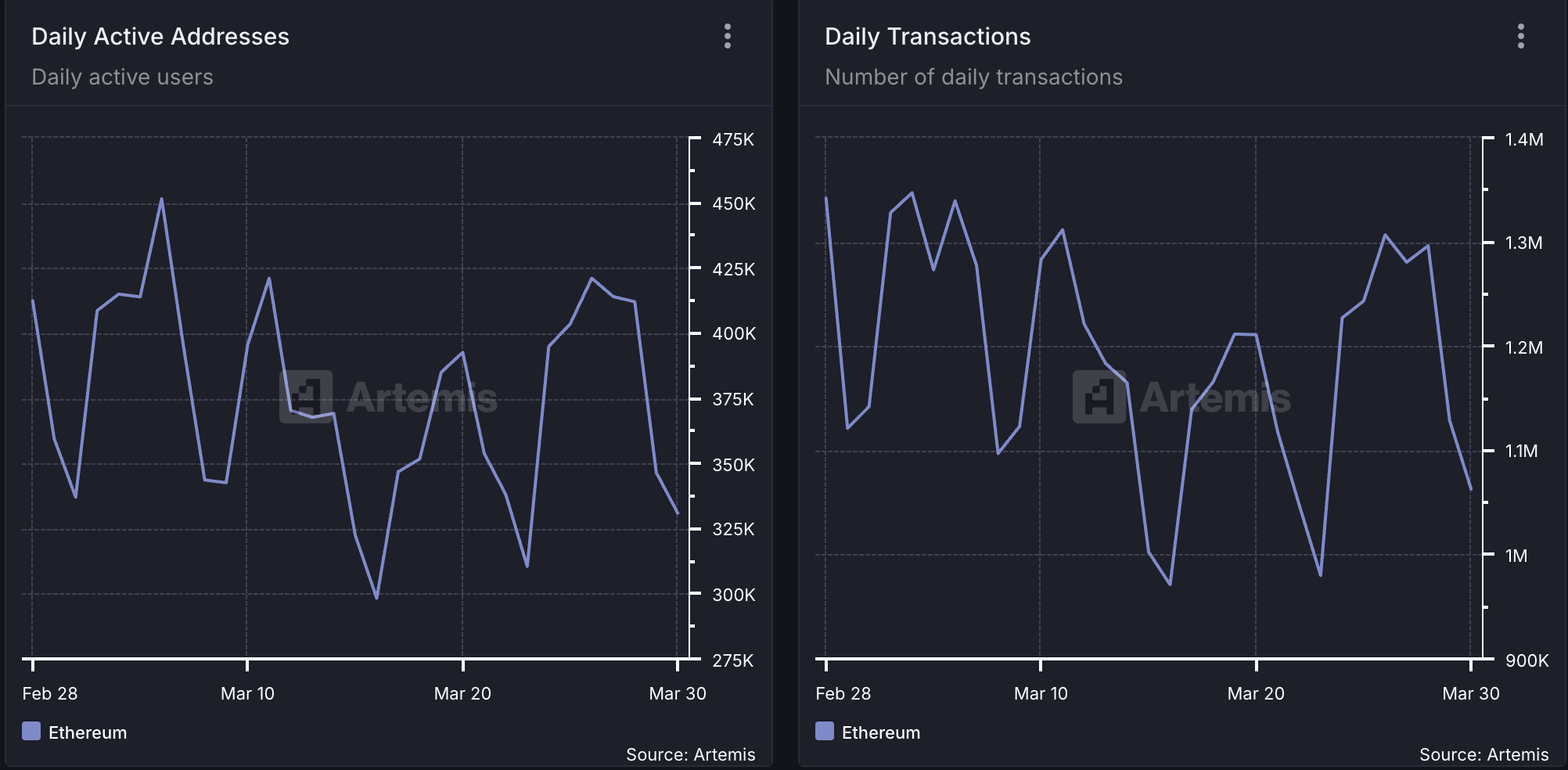
Generally, as more users transact and engage with Ethereum, the burn rate (a measure of ETH tokens permanently removed from circulation) increases, contributing to Ether’s deflationary supply dynamic. However, when user activity drops, ETH’s burn rate reduces, leaving many coins in circulation and adding to its circulating supply.
This was the case for ETH in March when it saw a spike in its circulating supply. According to data from Ultrasound Money, 74,322.37 coins have been added to ETH’s circulating supply in the past 30 days.
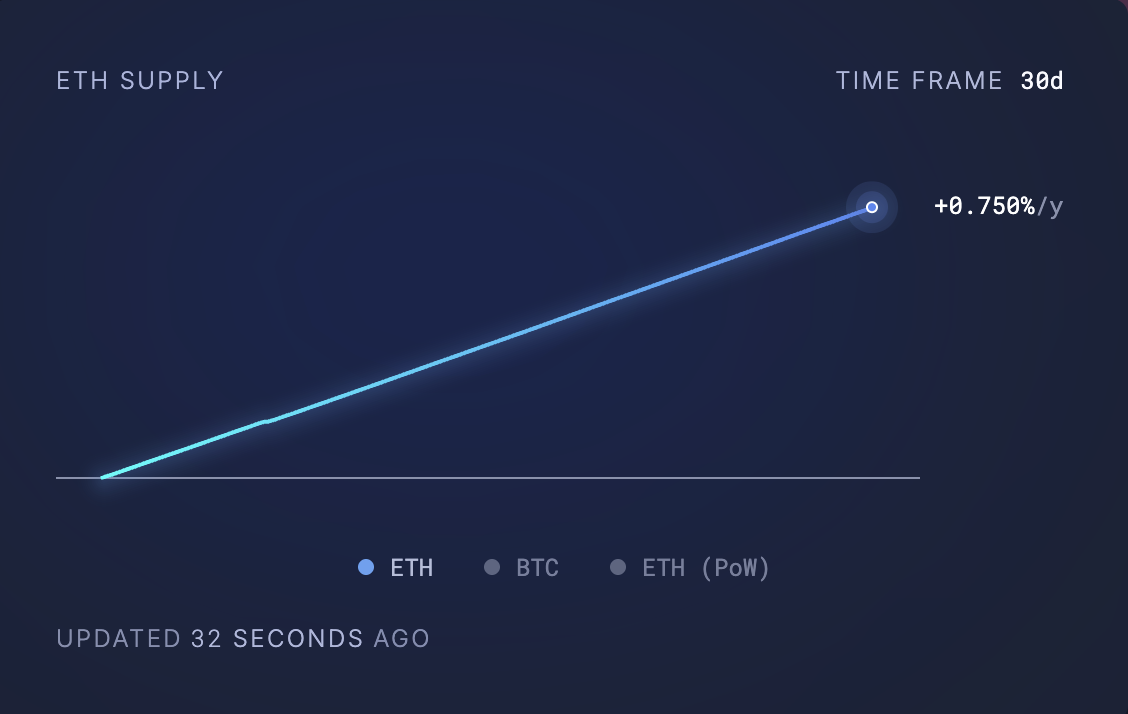
Usually, when an asset’s supply spikes like this without a corresponding demand to absorb it, it increases the downward pressure on its price. This puts ETH at risk of extending its decline in April.
What’s Next for Ethereum? Expert Says Inflation May Not Be a Major Concern
In an exclusive interview with BeInCrypto, Gabriel Halm, a Research Analyst at IntoTheBlock, noted that ETH’s current inflationary trends “may not be a major red flag” to watch out for in April.
Halm said:
“Even though Ethereum’s supply has recently stopped being deflationary, its annualized inflation rate is still only 0.73% over the last month, which is still dramatically lower than pre-Merge levels and lower than that of Bitcoin. For investors, this moderate level of inflation may not be a major red flag, provided that network usage, developer activity, and institutional adoption remain robust.”
Moreover, regarding whether Ethereum’s declining network activity has played a significant role in its recent price struggles, Halm suggested that its impact may be overstated.
“Historically, from September 2022 to early 2024, Ethereum’s supply remained deflationary, yet the ETH/BTC pair still trended lower. This suggests that macroeconomic and broader market forces can play a far more significant role than token supply changes alone.”
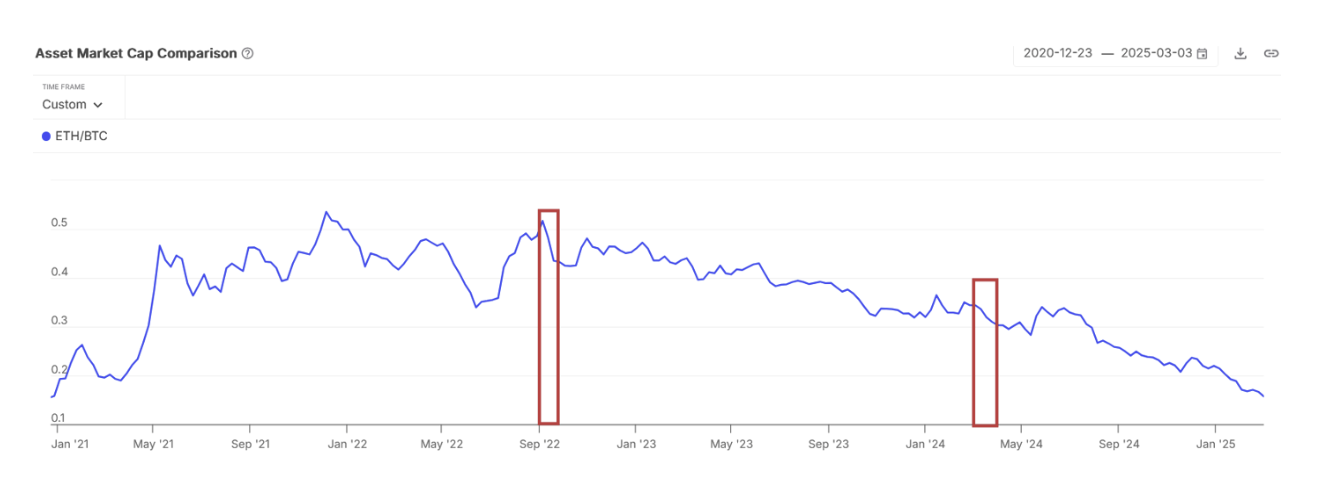
On what ETH holders should anticipate this month, Halm said:
“Ultimately, whether Ethereum dips or rallies in April will likely depend more on market sentiment and macro trends than on its short-term supply dynamics. Still, it’s essential to keep an eye on network developments that could spur renewed activity and reinforce ETH’s leading position in the broader crypto landscape.”
Disclaimer
In line with the Trust Project guidelines, this price analysis article is for informational purposes only and should not be considered financial or investment advice. BeInCrypto is committed to accurate, unbiased reporting, but market conditions are subject to change without notice. Always conduct your own research and consult with a professional before making any financial decisions. Please note that our Terms and Conditions, Privacy Policy, and Disclaimers have been updated.
Market
Binance Faces Community Backlash and Boycott Calls


Controversies surrounding token listings, the depegging of the FDUSD stablecoin, and allegations of unethical behavior have raised a crucial question: Is Binance losing its credibility?
These issues threaten to erode trust and challenge Binance’s standing in the crypto industry.
Binance Struggles to Meet the Standard
One of Binance‘s most pressing issues is the poor performance of the tokens listed on the exchange. As BeInCrypto reported earlier, 89% of the tokens listed on the platform in 2025 recorded negative returns.
Even more concerning, another report reveals that most of the tokens listed in 2024 also experienced negative performance.
Listing on Binance was once considered a “launchpad” for new projects. However, it no longer guarantees success.
A prime example is the ACT token, a meme coin listed on the exchange that quickly plummeted. Earlier this week, Wintermute—a major market maker—dumped a large amount of ACT, exerting strong downward pressure on its price and raising concerns about the transparency of Binance’s listing process.
Such criticism has led the community to believe Binance prioritizes listing fees over users’ interests.
Connection to FDUSD
The FDUSD stablecoin has also become a focal point of controversy, with Binance at its center. FDUSD lost its peg, dropping to $0.89 after reports surfaced that its issuing company had gone bankrupt.
Wintermute, one of the largest FDUSD holders outside of Binance, withdrew 31.36 million FDUSD from the exchange at 11:15 AM UTC. This move is believed to have exacerbated the depegging situation, sparking panic in the market.
More concerning, a community member claimed that some Binance employees leaked internal information about the FDUSD incident so they could select whale chat groups.
If true, this would severely damage Binance’s reputation and raise major questions about the platform’s transparency and ethics.
Overall, the community’s dissatisfaction is growing, with many users calling for a boycott of the exchange. Such negative reactions are shaking user confidence in the platform, which was once considered a symbol of credibility in the crypto space.
“Binance today caused massive liquidations on alts listed on their exchange. I warned you all yesterday about their very dirty tactics, specifically GUN. I refuse to use Binance #BoycottBinance,” wrote popular crypto YouTuber Jesus Martinez.
These accusations stem from a central issue that Binance prioritizes profits over user interests. Over the past few months, the community has constantly criticized its listing strategy, arguing that the exchange focuses on “shitcoins” to collect high listing fees without considering project quality.
Although the exchange recently introduced a community voting mechanism to decide on listings, this might not be enough to silence the criticism.
As a Tier-1 exchange, the company is evaluated based on trading volume, security, regulatory compliance, and community trust. However, recent events suggest that the exchange is struggling to maintain these standards.
Disclaimer
In adherence to the Trust Project guidelines, BeInCrypto is committed to unbiased, transparent reporting. This news article aims to provide accurate, timely information. However, readers are advised to verify facts independently and consult with a professional before making any decisions based on this content. Please note that our Terms and Conditions, Privacy Policy, and Disclaimers have been updated.
Market
Stellar (XLM) Falls 5% as Bearish Signals Strengthen

Stellar (XLM) is down more than 5% on Thursday, with its market capitalization dropping to $8 billion. XLM technical indicators are flashing strong bearish signals, suggesting continued downward momentum that could test critical support levels around $0.22.
While a reversal scenario remains possible with resistance targets at $0.27, $0.29, and $0.30, such an upside move would require a substantial shift in market sentiment.
XLM RSI Shows Sellers Are In Control
Stellar’s Relative Strength Index (RSI) has dropped sharply to 38.99, down from 59.54 just two days ago—signaling a notable shift in momentum.
The RSI is a widely used momentum oscillator that measures the speed and magnitude of recent price changes, typically ranging between 0 and 100.
Readings above 70 suggest overbought conditions, while levels below 30 indicate oversold territory. A reading between 30 and 50 often reflects bearish momentum but is not yet extreme enough to trigger an immediate reversal.

With Stellar’s RSI now below the key midpoint of 50 and approaching the oversold threshold, the current reading of 38.99 suggests that sellers are gaining control.
While it’s not yet in oversold territory, it does signal weakening buying pressure and increasing downside risk.
If the RSI continues to fall, XLM could face further price declines unless buyers step in soon to stabilize the trend and prevent a slide into more deeply oversold levels.
Stellar CMF Heavily Dropped Since April 1
Stellar’s Chaikin Money Flow (CMF) has plunged to -10, a sharp decline from 0.19 just two days ago, signaling a significant shift in capital flow dynamics.
The CMF is an indicator that measures the volume-weighted average of accumulation and distribution over a set period—essentially tracking whether money is flowing into or out of an asset.
Positive values suggest buying pressure and accumulation, while negative values point to selling pressure and capital outflow.

With XLM’s CMF now deep in negative territory at -10, it indicates that sellers are firmly in control and substantial capital is leaving the asset.
This level of negative flow can put downward pressure on price, especially if it aligns with other bearish technical signals. Unless buying volume returns to offset this outflow, XLM could continue to weaken in the near term.
Will Stellar Fall To Five-Month Lows?
Stellar price action presents concerning signals as EMA indicators point to a strong bearish trend with significant downside potential.
Technical analysis suggests this downward momentum could push XLM to test critical support around $0.22. It could breach this level and fall below the psychologically important $0.20 threshold—a price not seen since November 2024.
This technical deterioration warrants caution from traders and investors as selling pressure appears to be intensifying.
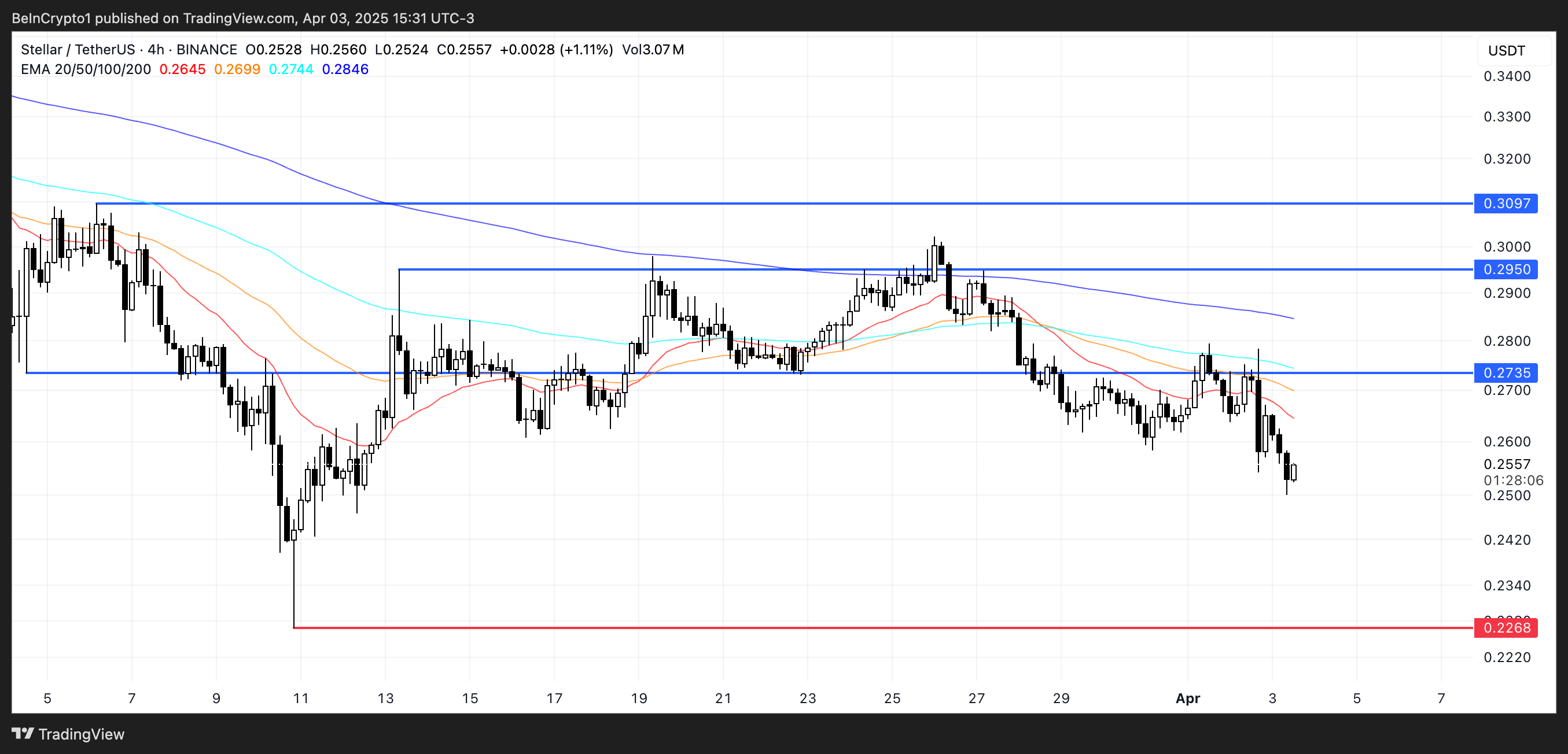
Conversely, a trend reversal scenario would require a substantial shift in market sentiment. Should bulls regain control, XLM could challenge the immediate resistance at $0.27, with further upside targets at $0.29 and the key $0.30 level.
However, this optimistic outlook faces considerable obstacles, as only a dramatic sentiment shift coupled with the emergence of a powerful uptrend would enable such a recovery.
Until clearer bullish signals manifest, the prevailing technical structure continues to favor the bearish case.
Disclaimer
In line with the Trust Project guidelines, this price analysis article is for informational purposes only and should not be considered financial or investment advice. BeInCrypto is committed to accurate, unbiased reporting, but market conditions are subject to change without notice. Always conduct your own research and consult with a professional before making any financial decisions. Please note that our Terms and Conditions, Privacy Policy, and Disclaimers have been updated.
-

 Market20 hours ago
Market20 hours agoCardano (ADA) Downtrend Deepens—Is a Rebound Possible?
-

 Altcoin21 hours ago
Altcoin21 hours agoAnalyst Forecasts 250% Dogecoin Price Rally If This Level Holds
-

 Market19 hours ago
Market19 hours agoEthereum Price Recovery Stalls—Bears Keep Price Below $2K
-
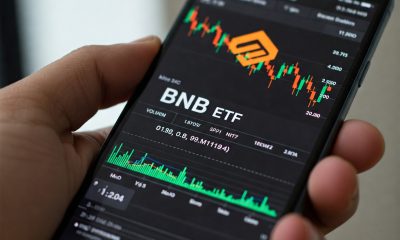
 Altcoin18 hours ago
Altcoin18 hours agoVanEck Seeks BNB ETF Approval—Big Win For Binance?
-

 Market21 hours ago
Market21 hours agoXRP Price Under Pressure—New Lows Signal More Trouble Ahead
-

 Market16 hours ago
Market16 hours agoIP Token Price Surges, but Weak Demand Hints at Reversal
-

 Ethereum16 hours ago
Ethereum16 hours agoEthereum Trading In ‘No Man’s Land’, Breakout A ‘Matter Of Time’?
-

 Bitcoin19 hours ago
Bitcoin19 hours agoUS Dollar Index Drops – What Does It Mean for Bitcoin?







